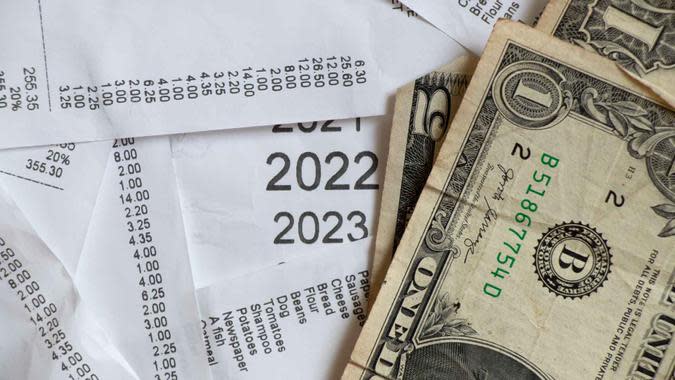9 Money Moves You Need To Make To Save 10%-15% of Your Salary for Retirement

The general recommendation for retirement savings is to put aside 10% to 15% of your pretax income toward retirement each year to be comfortable at this stage of life. Yet, according to a 2024 GOBankingRates survey, only 11% of respondents put away even 10%, and even fewer people put away more.
Find Out: Here’s the Cost To Retire Comfortably in Every State by Age
Read More: One Smart Way to Grow Your Retirement Savings in 2024
While increased costs of living might make it seem harder to squeeze out extra dollars toward retirement, there are some strategies that can make this much easier.
Experts explain nine money moves that will get you to your retirement savings goals.

Track and Budget
The first step is to make a detailed budget that lists all of your monthly income and spending first, according to Garreth Smith, a financial advisor, CCO and business partner at Ascend Investment Partners.
Once you figure out your true required living expenses, “You can scrutinize your discretionary spending and find extra cash to save and invest,” added Tyler Weerden, financial planner and founder of Layered Financial.
Learn More: Net Worth for Retirees: How To Tell If You’re Poor, Middle Class, Upper Middle Class or Rich
Check Out: Cutting Expenses in Retirement: 9 Things To Downsize (That Aren’t Your Home)

Maximize Your Employer Match
Perhaps the best way to achieve that 15% without actually having to part with 15% of your salary is to take advantage of an employer match, Weerden said.
“The match is about more than money, it’s about time,” he said.
He gives a hypothetical example of a person making $70,000 annually, earning roughly $2,692 gross per pay period, receiving a 5% match from one or more employers through a plan such as a 401(k), TSP, 403(b) or 457 plan.
“If you get this 5% match for 30 years, and that money has an annualized return of 7%, your retirement account will have roughly $339,000 just from the match,” he pointed out.
Explore More: 7 Bills You Never Have To Pay When You Retire

Automate Your Investing
Weerden also suggested you “fight human nature by automating your investing.”
What he means is that people have a tendency to spend money before they can get to saving it.
“If someone has $300 left at the end of the month after paying their expenses, they tend to categorize it as ‘extra’ and spend it. Instead think of your budget formula as income minus saving and investing equals expenses,” he explained.
This “profit first” method where you automate saving and investing directly from your paycheck will boost your portfolio without you even realizing it, Weerden said.
Additionally, if you max out your employer retirement plans but that ends up being less than 15% of your salary, Jennifer Kirby, fiduciary chartered SRI counselor and a certified investment management analyst(r) with Talisman Wealth Advisors, suggested starting an after-tax savings discipline where you automatically move money out of your checking account into a savings vehicle, like a brokerage account.
“Much like your employer-sponsored plan, automating the savings is very effective, and helps you get accustomed to living within your means in a controlled way,” Kirby said.

Invest Your Pay Raises
If you’re already automating, it’s a simple leap to then automate some or all of your pay raises each time you receive one, as well, Weerden said.
“The power of compounding interest makes time our most valuable asset. Someone who starts investing at age 20 versus age 30 will have a much easier journey to financial freedom by simply getting their dollars compounding sooner.”

Make Sensible Investments
Additionally, how and when you invest makes a difference, Smith said.
“Select investments from your retirement accounts based on your long-term objectives and risk tolerance. For long-term risk mitigation and return maximization, diversification is essential.”
Discover More: 3 Ways Upper Middle Class Retirees Stay Rich in Retirement

Utilize FinTech Apps for Micro-Investing
An unusual strategy for putting away more money into retirement involves leveraging financial technology applications, according to Jeff Mains, founder of business growth company, Champion Leadership Group LLC.
“[These apps] round up your daily transactions to the nearest dollar and invest the spare change into a retirement account.”
“This method is particularly compelling because it seamlessly integrates saving into everyday activities without significantly changing spending habits,” he explained.
Additionally, many of these apps offer the option to automatically increase your investment percentage over time, he said, subtly nudging you to save more as you become more comfortable with the process.
“It’s a unique approach because it capitalizes on the cumulative power of micro-investments, which can add up significantly over time, making reaching the 15% savings goal easier.”

Implement a Behavioral ‘Tax’ on Nonessential Purchases
Another way to carve out extra money from your budget, Mains said, is to “[c]reate a personal rule where for every dollar spent on nonessential items like dining out, entertainment, etc., a certain percentage, like 20% to 30%, is contributed to your retirement savings.”
He said this method encourages more mindful spending on luxuries and turns these expenditures into opportunities to boost your retirement savings.
“It’s a form of self-imposed tax that benefits your future self,” Mains said.

Withhold the Maximum From Your Paycheck
Studies have shown repeatedly that the most effective way to save for retirement is to withhold the maximum amount possible from your paycheck into an employer-sponsored plan, such as a 401(k) or 403(b), Kirby said.
“This can also have the added benefit of employer matches and tax deferral. If you withhold pre-tax dollars into an employer plan, that is less salary on which you will be taxed today. Some plans also offer a Roth option which allows you to save after-tax dollars which will accumulate and grow tax-free forever,” she said.
Read Next: 9 Ways Frugal Retirees Spend Their Social Security Checks

Seek Expert Advice
All of that said, trying to make these decisions on your own can feel overwhelming.
“Think about speaking with a financial advisor who can offer specialized counsel and advice based on your unique financial circumstances and retirement objectives,” Smith said.
More From GOBankingRates
This article originally appeared on GOBankingRates.com: 9 Money Moves You Need To Make To Save 10%-15% of Your Salary for Retirement

 Yahoo Finance
Yahoo Finance 